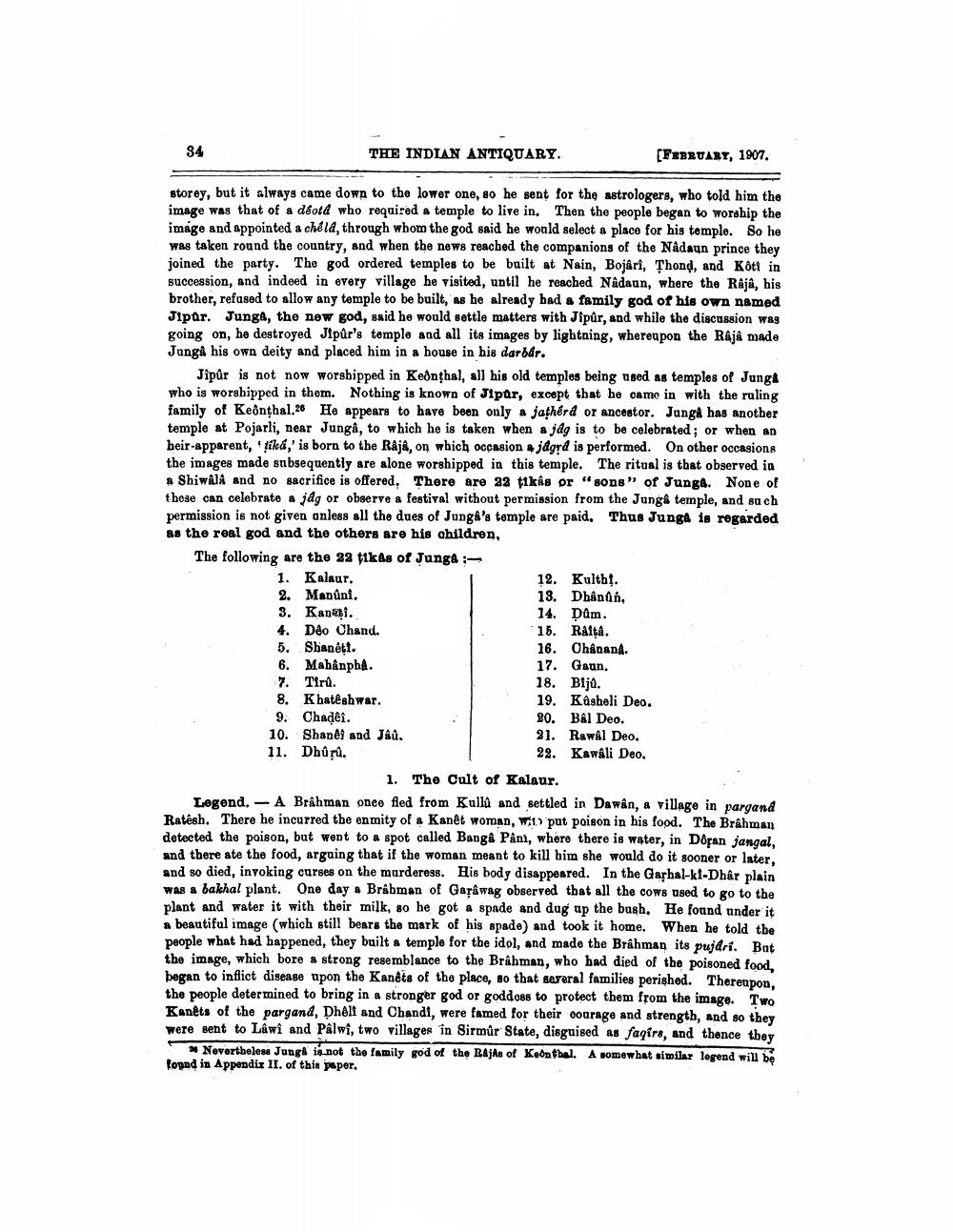________________
34
THE INDIAN ANTIQUARY.
[FEBRUABY, 1907.
storey, but it always came down to the lower one, so he sent for the astrologers, who told him the image was that of a dotd who required a temple to live in. Then the people began to worship the image and appointed a chala, through whom the god said he would select a place for his tomple. So he was taken round the country, and when the news reached the companions of the Nadaun prince they joined the party. The god ordered temples to be built at Nain, Bojári, Thond, and Kôti in succession, and indeed in every village he visited, until he reached Nâdaun, where the Raja, bis brother, refused to allow any temple to be built, as he already bad a family god of his own named Jipar. Junga, the new god, said he would settle matters with Jipůr, and while the discussion wag going on, he destroyed Jipur's temple and all its images by lightning, whereupon the Râjâ made Jungå his own deity and placed him in a house in his darbdr.
Jipûr is not now worshipped in Keðnthal, all his old temples being used as temples of Junga who is worshipped in them. Nothing is known of Jipar, except that he came in with the ruling family of Keônthal.26 He appears to have been only a jathếrd or ancestor. Jungê has another temple at Pojarli, near Junga, to which he is taken when jag is to be celebrated; or when an heir-apparent, 'fild,' is born to the Raja, on which occasion jdgyd is performed. On other Occasions the images made subsequently are alone worshipped in this temple. The ritual is that observed in
Shiwald and no sacrifice is offered. There are 32 tikas or "sons" of Jung. None of those can celebrate a jdg or observe a festival without permission from the Junga temple, and such permission is not given anless all the dues of Jung&'s temple are paid. Thus Junga is regarded as the real god and the others are his children, The following are the 22 tikas of Jung& 1. Kalaur.
12. Kultht. 2. Manuni,
13. Dhanan, 3. Kanai.
14. Dam. 4. Déo Chand.
15. Raita. 5. Shanett.
16. Ohanana. 6. Mehânphi.
17. Gaun. 7. Tiru.
18. Biju. 8. Khatêshwar.
19. Kasheli Deo. 9. Chadei.
20. Bal Deo. 10. Shanêî and Jáu.
91. Rawal Deo. 11. Dhûrů.
22. Kawali Deo.
1. The Cult of Kalaur. Legend. - A Brahman onee fled from Kullo and settled in Dawân, a village in pargand Ratesh. There he incurred the enmity of Kanêt woman, W.1) put poison in his food. The Brahman detected the poison, but went to a spot called Banga Pâni, where there is water, in Dopan jangal, and there ate the food, arguing that if the woman meant to kill him she would do it sooner or later, and so died, invoking curses on the murderess. His body disappeared. In the Gaphal-ki-Dhår plain was a bakhal plant. One day a Brabman of Garâwag observed that all the cows used to go to the plant and water it with their milk, so he got a spade and dug up the bush. He found under it a beautiful image (which still bears the mark of his spade) and took it home. When he told the people what had happened, they built a temple for the idol, and made the Brahman its pujdrí. Bat the image, which bore a strong resemblance to the Brâhman, who had died of the poisoned food, began to inflict disease upon the Kanêts of the place, so that several families perished. Thereupon, the people determined to bring in a stronger god or goddess to protect them from the image. Two Kanets of the pargand, Dhéli and Chandi, were famed for their courage and strength, and so they were sent to Liwi and Palwi, two villages in Sirmûr State, disguised as faqirs, and thence they
Nevertheless Jungs is.not the family god of the Bajas of Koonthal. A somewhat similar legend will be topnd in Appendix II. of this peper.




